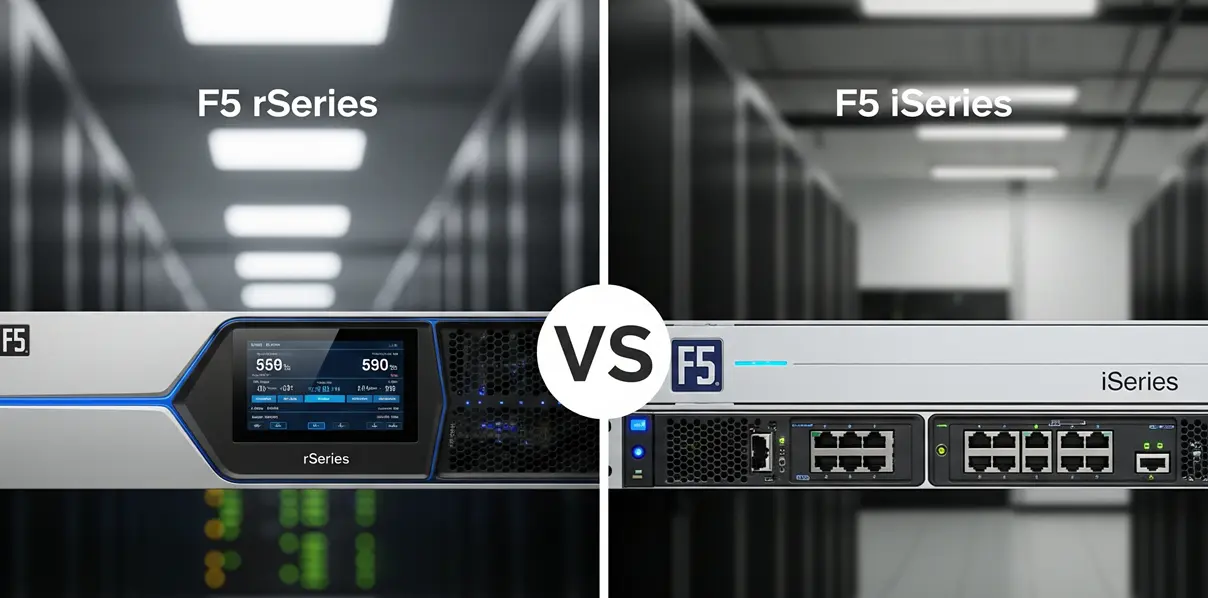Quote for F5 Appliance
If you’re new to F5 BIG-IP, you might notice that there are two series of devices on the F5 official site: iSeries and rSeries. At first glance, they both look like rack-mounted network devices with similar features, but there are actually some key differences. Put it simply, iSeries is the older generation, while rSeries is the newer, upgraded version.
Similarly, F5’s rSeries has seen comprehensive upgrades in hardware, performance, and management experience. This article helps you quickly grasp the differences between the two hardware generations, so you won’t be confused by complex specifications.
F5 rSeries vs iSeries Table
From the following data table, you could get a quick overview of the difference between the two series.
| Feature / Aspect | iSeries (Older Generation) | rSeries (Next-Generation) |
|---|---|---|
| Design & Form Factor | Traditional 1U/2U rack-mounted, designed for mid-range enterprises | Modern 1U rack-mounted, compact design with higher performance and more ports |
| Network Interfaces | Limited ports, supports up to 40GbE | More ports, supports 10/25/40/100GbE |
| CPU & Processing | Intel processors with hardware offload for SSL/TLS and compression | Latest Intel CPUs with FPGA offload for SSL/TLS and compression |
| Layer 7 Requests per Second (L7 RPS) | Up to 6.6 million | Up to 6.6 million |
| Layer 4 Connections per Second (L4 CPS) | Up to 2.5 million | Up to 2.5 million |
| Layer 4 HTTP Requests per Second (L4 HTTP RPS) | Up to 37 million | Up to 37 million |
| Maximum L4 Concurrent Connections | Up to 180 million | Up to 180 million |
| Throughput (L4/L7) | Up to 190 Gbps | Up to 190 Gbps |
| SSL/TLS Offload Performance | Supports up to 45,000 TPS (2K RSA) | Supports up to 45,000 TPS (2K RSA) |
| ECC Offload Performance | Supports up to 20,000 TPS (ECDHE) | Supports up to 20,000 TPS (ECDHE) |
| Management & UI | Traditional interface with manual operations | F5OS with intuitive interface, multi-tenant support, API automation |
| Target Use Cases | Legacy systems, small businesses, low-performance needs | New deployments, medium-large enterprises, data centers, hybrid cloud environments |
Appearance and Hardware Differences
F5 iSeries uses a traditional rack-mounted design, mainly aimed at mid-sized businesses and legacy system setups. It has fewer interfaces and moderate processing power, so it works well for situations with lower performance requirements.
F5 rSeries, including models like the R2600 and F5 R4800, is the next-generation rack-mounted device, featuring more powerful hardware performance, more interfaces, and support for high-speed network ports (25/40/100GbE), capable of meeting modern enterprises’ demands for high-speed networking.
Tip: At first glance, the iSeries and rSeries may seem similar, but the rSeries offers higher processing power and scalability internally, making future upgrades more convenient.
Performance Enhancements
The performance improvements of the rSeries are significant:
- Faster processing power: rSeries is equipped with more CPU cores, enabling it to handle more network requests simultaneously and reduce latency.
- Faster encryption speed: SSL/TLS encryption processing is faster, ensuring smoother access to websites and applications.
- Higher throughput: Supports more users accessing simultaneously, making it ideal for medium to large enterprises and data centers.
To put it another way, the iSeries’ desk can only hold three or four documents, while the rSeries’ desk can hold ten or more documents at once, naturally improving processing efficiency. For environments requiring high concurrent access or large-scale traffic, the rSeries is the clear performance winner.
Security and management upgrades
The rSeries has also been upgraded in terms of security and management experience:
- Enhanced security: The rSeries supports more advanced encryption technologies (such as TLS 1.3) and hardware security modules, providing better protection against network attacks.
- Improved management: The rSeries runs the F5OS system, which features an intuitive interface, supports multi-tenant management, and provides automated APIs, making it easier for enterprises to manage and maintain their systems.
In contrast, the iSeries has a more traditional management interface that requires more manual operations. For beginners, managing the rSeries is like using a new smartphone operating system: the interface is clear, the features are rich, and the operations are simple.
Application Scenarios
iSeries: Maintenance of legacy systems, small businesses, environments with low performance requirements
rSeries: New deployments, medium to large enterprises, data centers, hybrid cloud environments
In other words, if you are building a new network system, rSeries is the more reasonable choice; if you are simply maintaining an existing legacy system, iSeries can still meet basic requirements.
Summary
In simple terms: rSeries = upgraded version of iSeries with:
- Higher performance: enhanced processing power, encryption speed, and throughput
- Stronger security: supports the latest encryption standards and hardware security modules
- More modern management: F5OS system, intuitive interface, automated management
If you’re planning to build a new network system, roll out high-traffic apps, or want room to grow in the future, the F5 rSeries is definitely the smarter pick, like like the R4800 or R10800 appliance. The iSeries works for small-scale setups or legacy systems, but it’s now behind the rSeries in performance, security, and management ease.

